Homemade Fusilli with Semolina Pasta Dough
This post may contain affiliate links. For more information, please see our disclosure policy.
Do you love to make homemade pasta? Or maybe you want to try your hand at a new kitchen project? Let’s learn two methods of making handmade fusilli, including a twisted pasta and a hollow rope, each made using fresh homemade semolina pasta dough.
Both types of pasta is formed using a metal fusilli iron (traditional method) or a wooden skewer.
This type of pasta, homemade fusilli, was made often in my mom’s hometown in Italy years and years ago. It’s often served with a simple easy marinara sauce or an Arrabbiata sauce if you like spice.
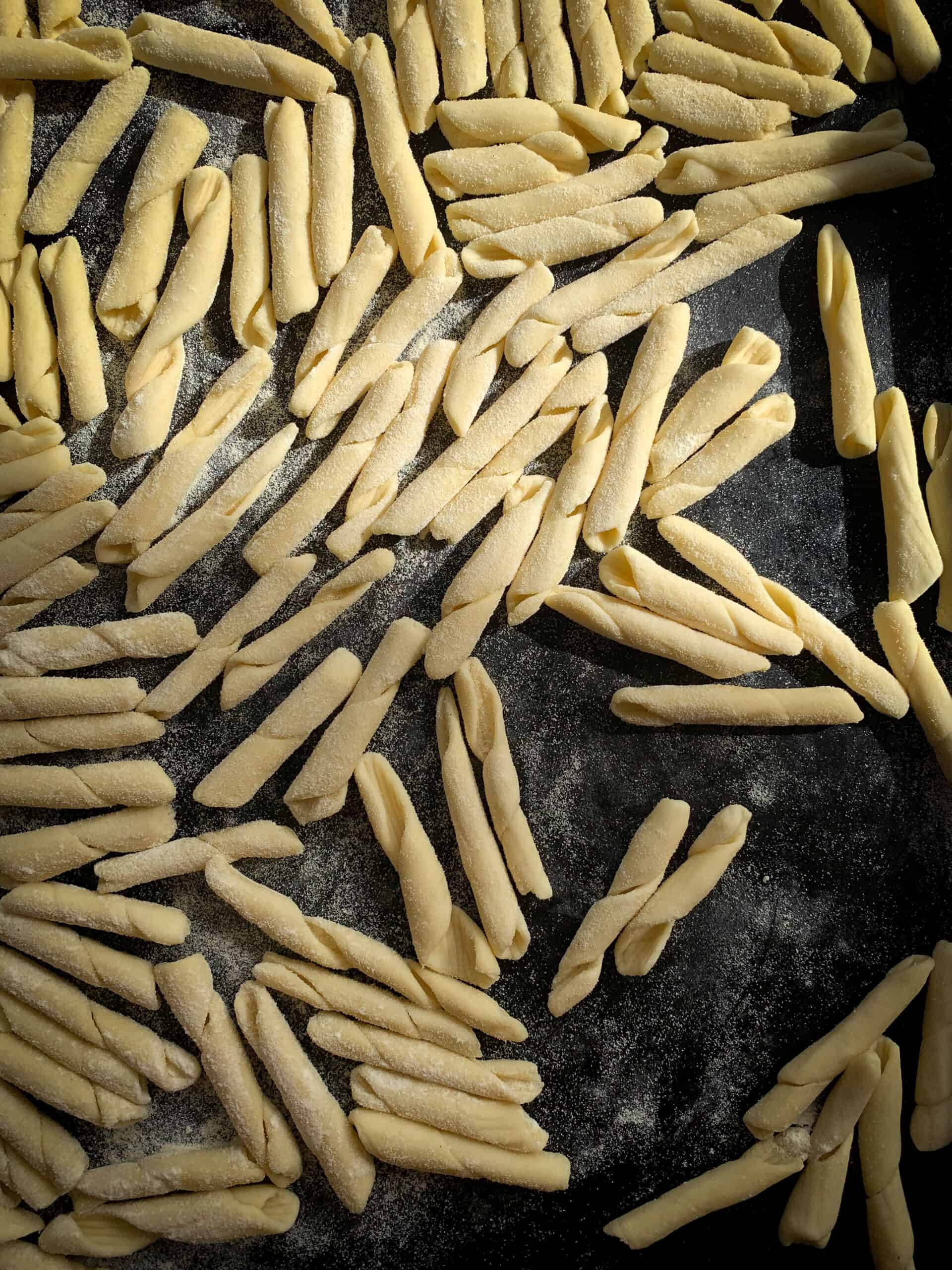
The shape shown above is more similar to the fusilli you see in the grocery store, which is spiralized.
Below, I show a more simple shape, also called “fusilli” but they are also known throughout Italy by different names including cannizzuoli, busiati, and maccheroni al ferro (macaroni from the iron/rod).
People from Calabria Italy are said to call this pasta fileja, also known as maccarunna or filedda.
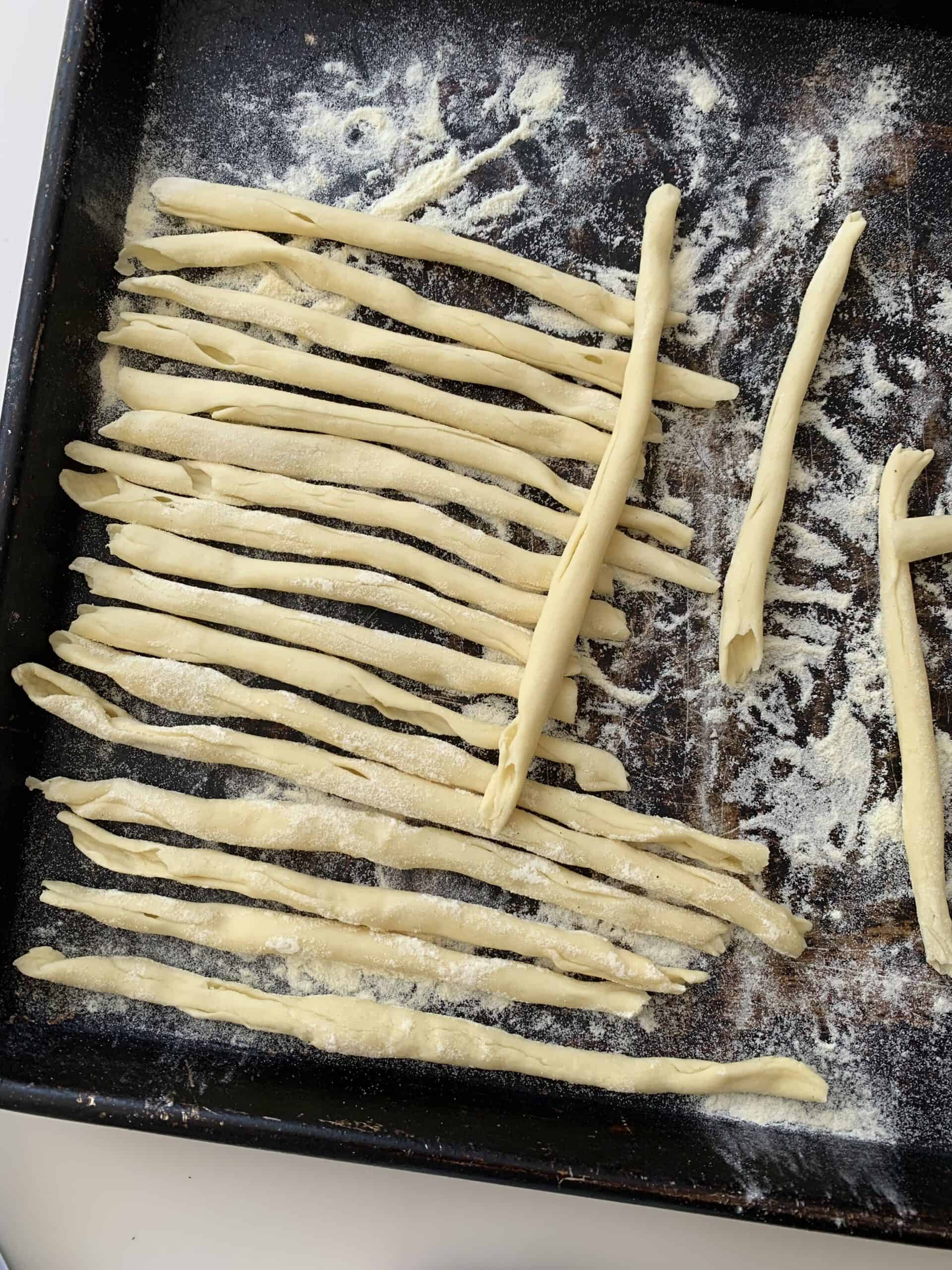
I think of pasta making (as well as bread baking) sort of like “kitchen therapy” – as they say, if you know, you know. And although this is more work than something simple like pasta and peas, it’s also so worthwhile!
That said, it’s of course, much easier to buy homemade pasta but – to me – making fresh pasta is not only therapeutic but a great way to spend time in the kitchen with your loved ones – friends, kids, spouse or parents.
After all, the more help, the more fun and the faster the pasta making goes.
Fusilli Iron
If you are interested in buying a fusilli iron, they are available at Fantes.com – the fusilli iron looks similar to a metal kabob skewer but is square in diameter instead of round.
You can use a wooden skewer in place of a fusilli iron. Women is Italy have been known to improvise by using a knitting needle or even the spoke from an umbrella!
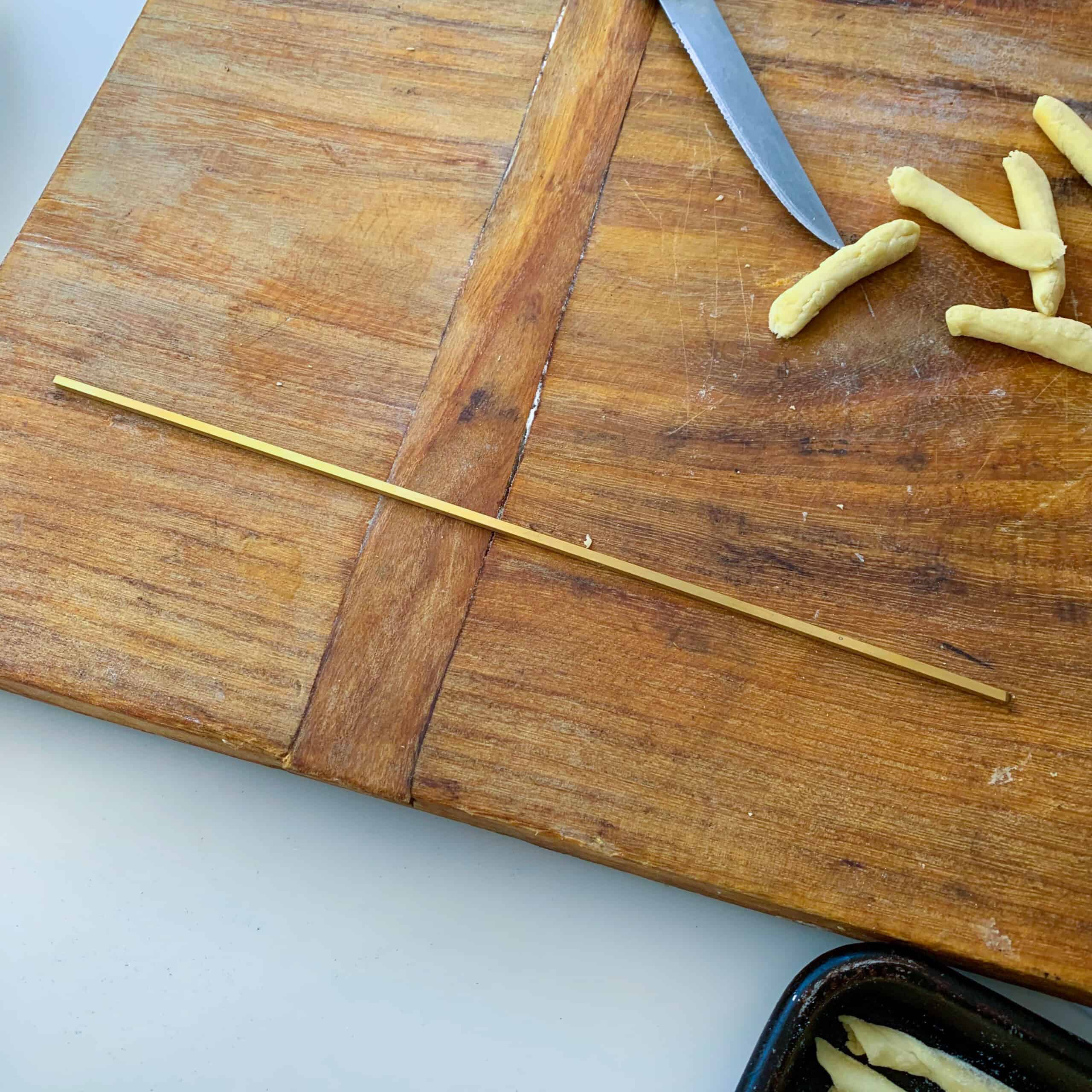
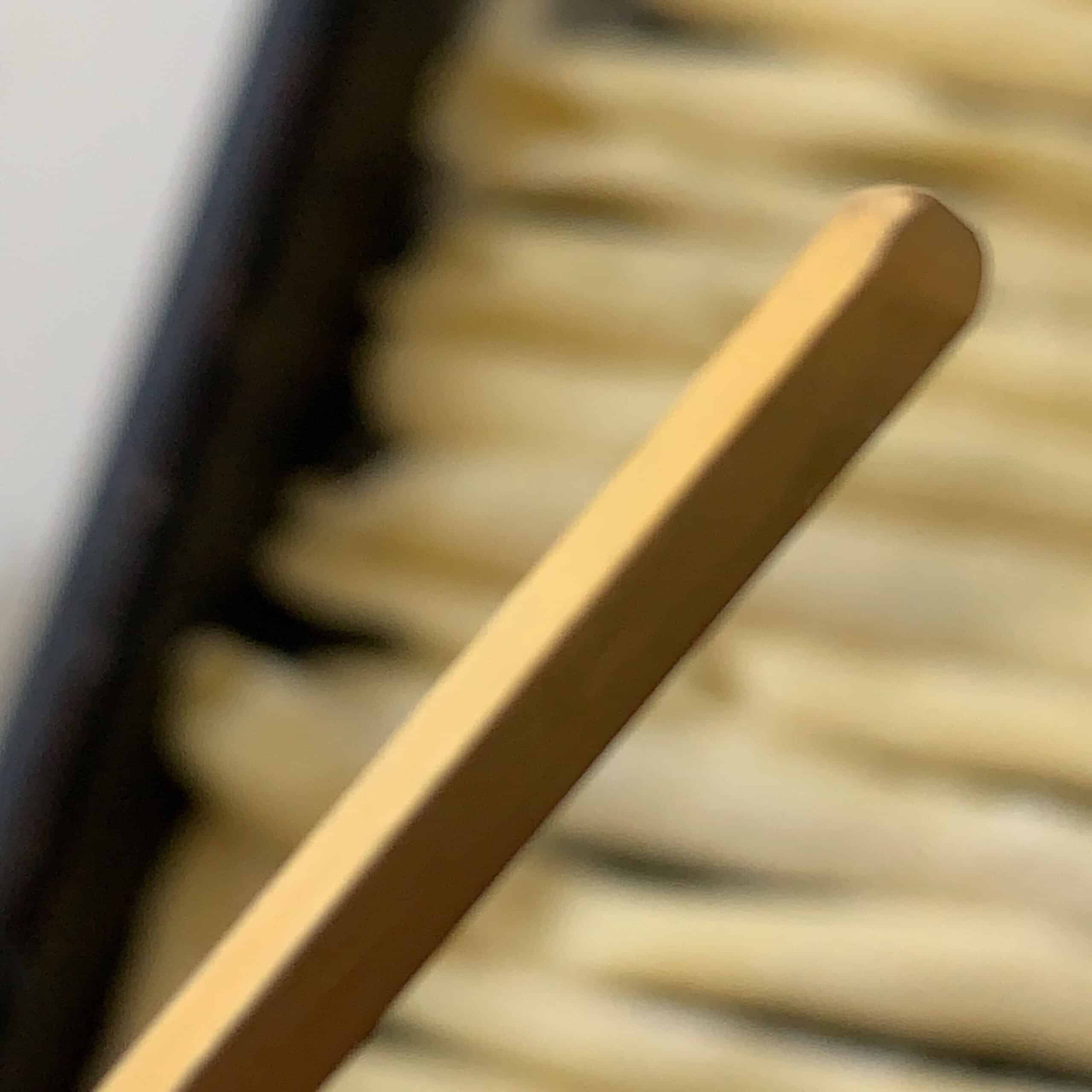
Eggless Pasta Dough Ingredients (Semolina Dough)
Making semolina-based pasta dough is so simple. The hardest part may be finding the main and only ingredient (aside from water), which is semolina rimacinata. This type of semolina is very finely ground like a powder. Rimacinata means “twice milled”. The flour may also be labeled “semola rimacinata”.
One of my good friends, Marisa, spent a few weeks in Italy this past summer. She shared this excellent recipe from the Italian pasta chef who demonstrated how to make semolina pasta dough.
For this pasta dough, you will need:
- Semolina rimacinata (rimacinata = “twice milled” or finely ground – make sure you are using the right kind of semolina – it should be powder like not coarse like grits!)
- Warm/hot water
The chef emphasized that you will get the best results by weighing the ingredients. By weight, the dough is simply made using a 2:1 ratio of semolina rimacinata (finely ground) and warm/hot water.
For approximately 1 pound of pasta, you will need 300 grams of semolina rimacinata and 150 grams of hot water.
The dough is a cinch to make – I find it easier to let it rest a bit between kneading to more easily get a smoothly developed dough.
I grew up eating my mom’s egg-based pasta dough and was looking for something a little different and dare I say easier. You may also use a standard egg pasta dough recipe.
Overview of method
First, you will make your pasta dough. It comes together quickly but you’ll need to let it rest for 30 minutes or more before shaping it.
To shape the pasta, there are two ways of making homemade fusilli.
Simple fusilli
- The first method is simply rolling small pieces of pasta around a brass rod to form a long strand that is hollow inside (similar to bucatini but more “rustic” looking).
- Remember to keep the unused portion of dough covered with a damp cloth at all times.
- If you have a wooden board, they work well for shaping pasta.




- Slide pasta strand off the rod and stage on a floured sheet pan. Repeat this process until all pasta is rolled.
- Ensure you keep the pasta that is not being actively worked covered well with a damp cloth.
Spiral fusilli
The other method is to make them spiralized, more similar to store bought fusilli. The second method is a little more challenging but I think also a little more fun.
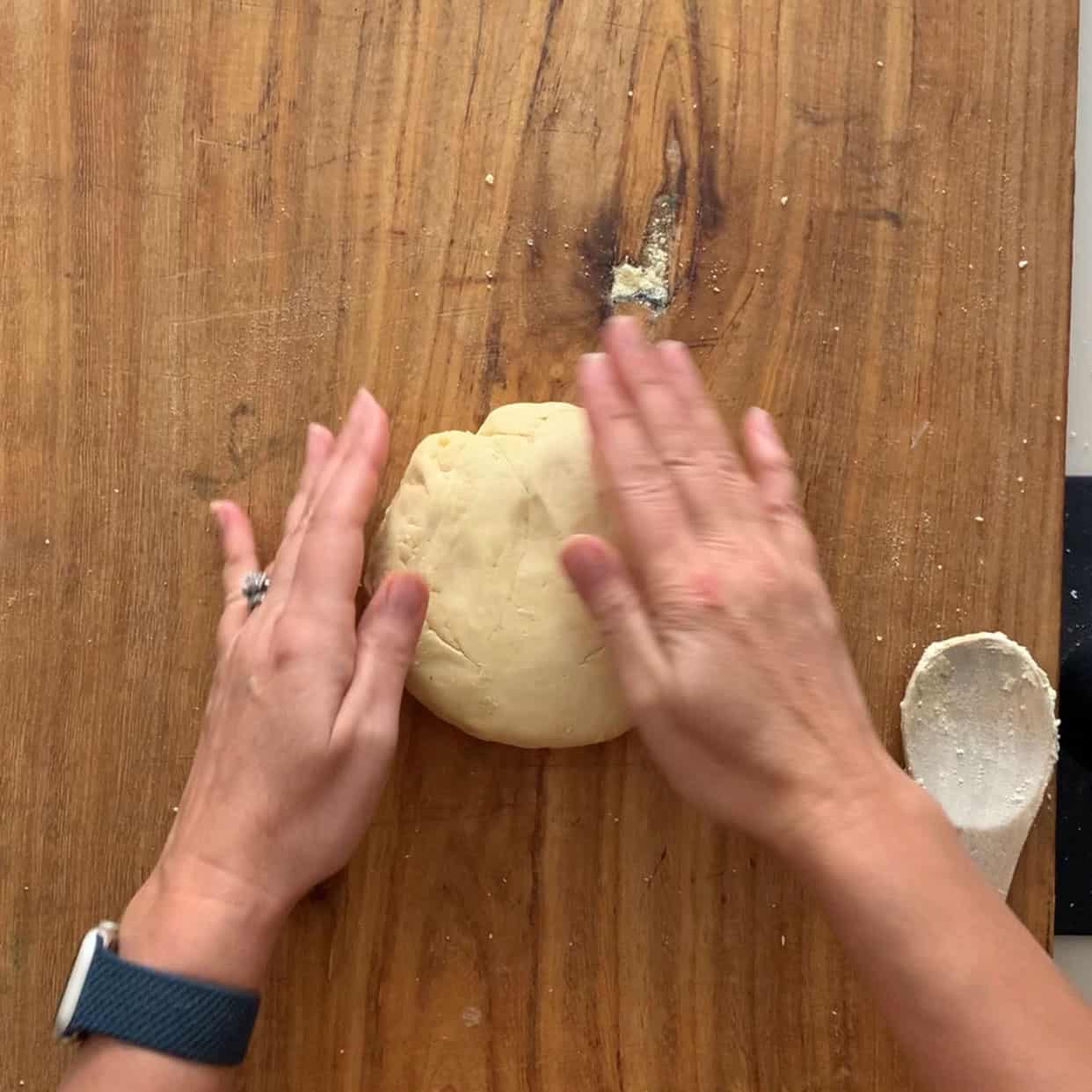
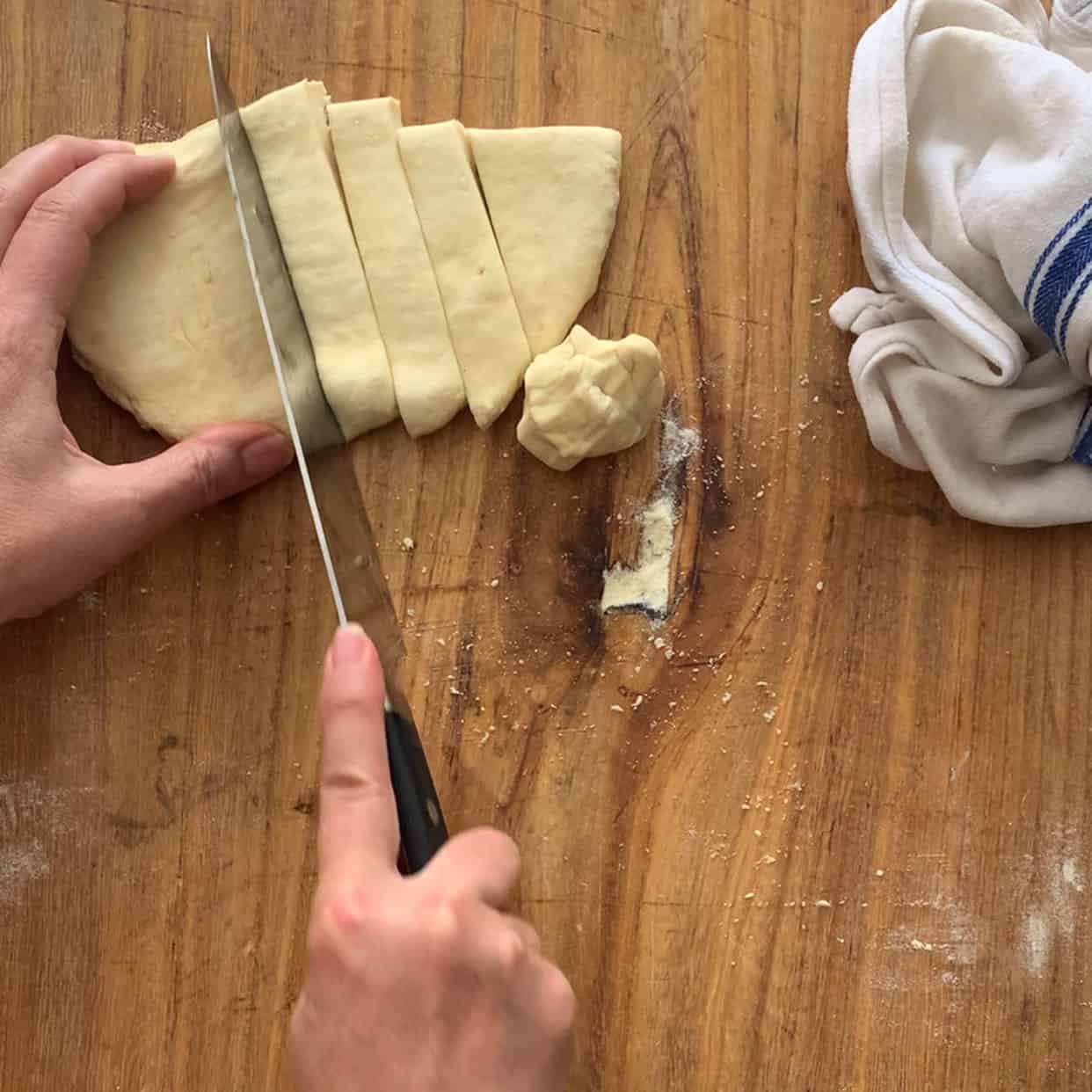

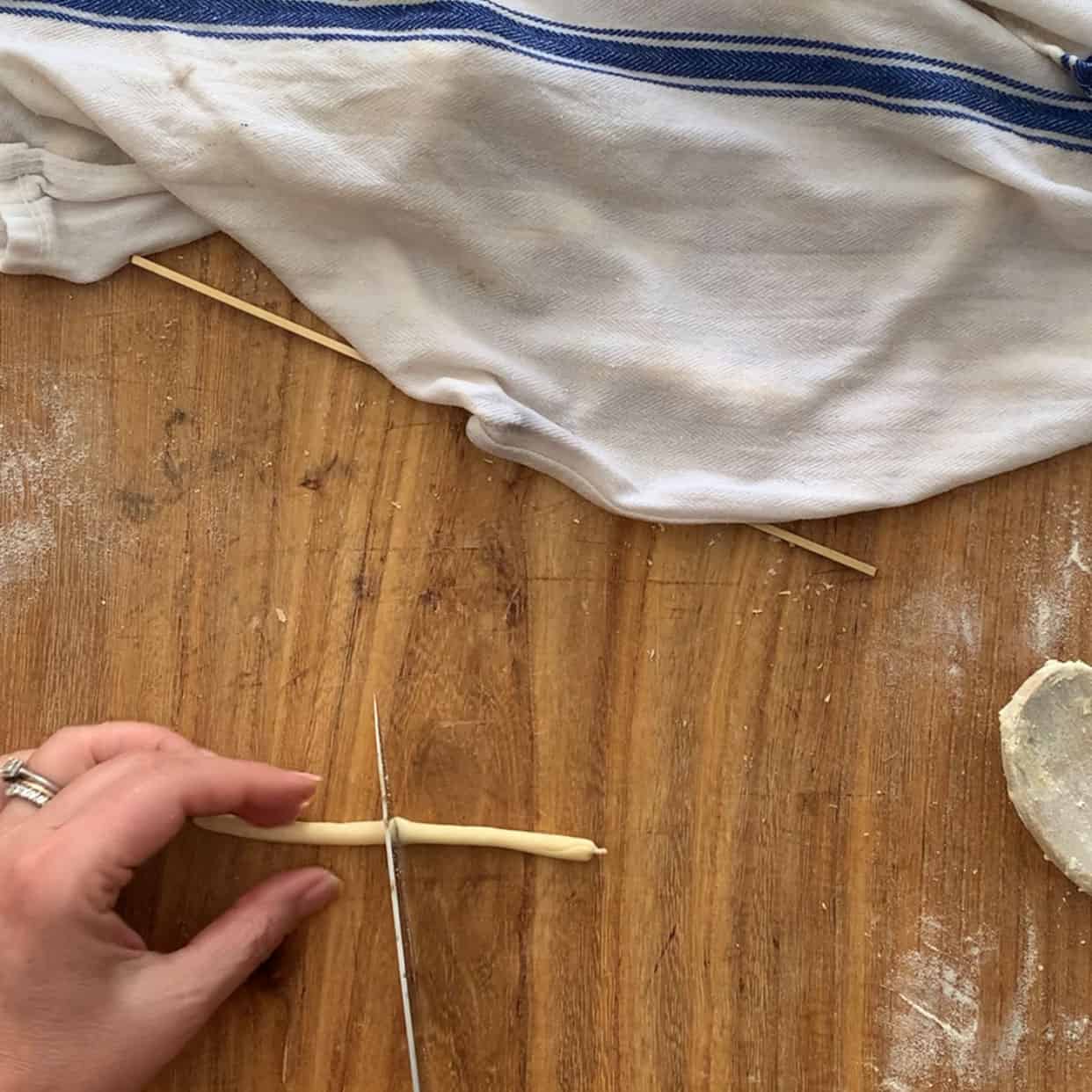
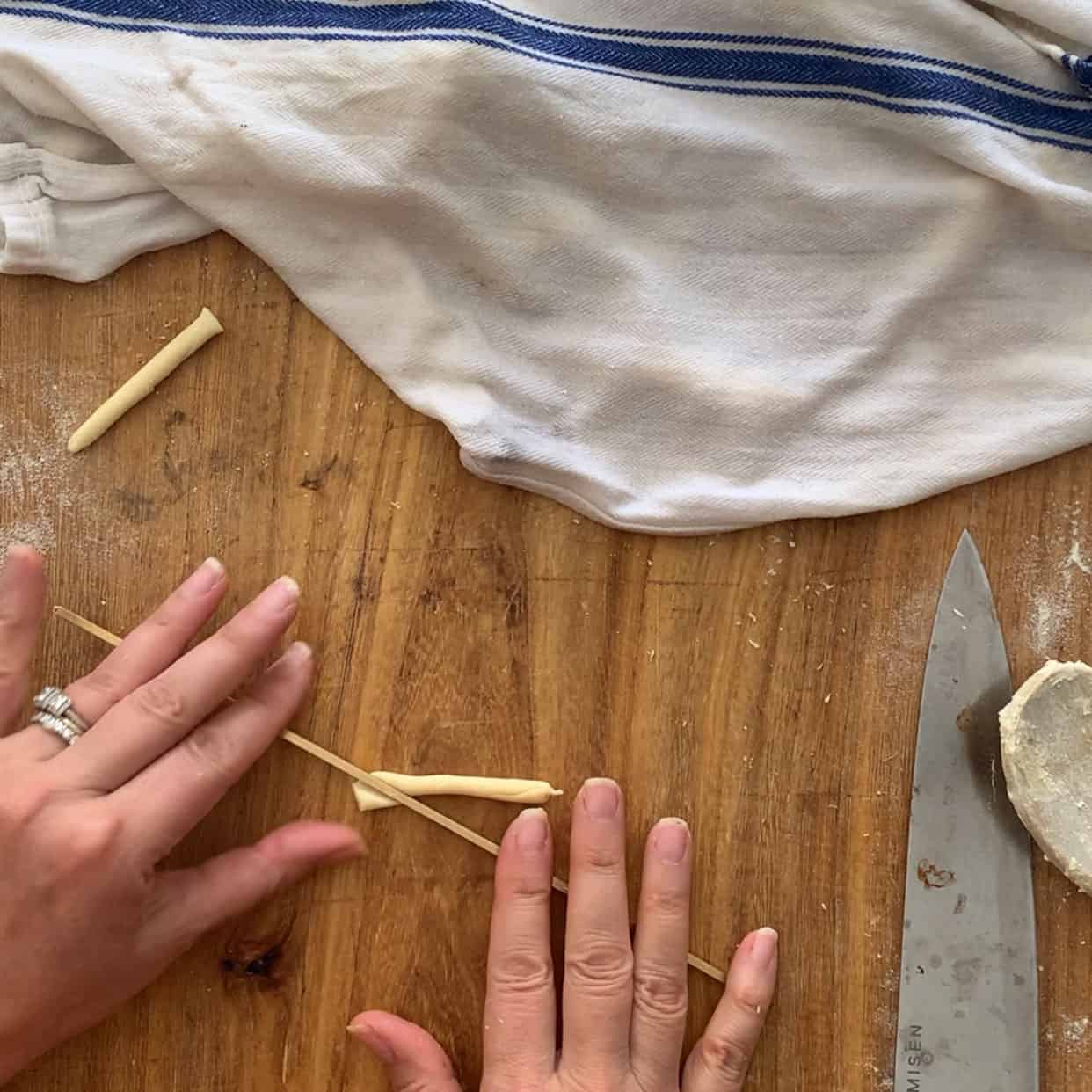
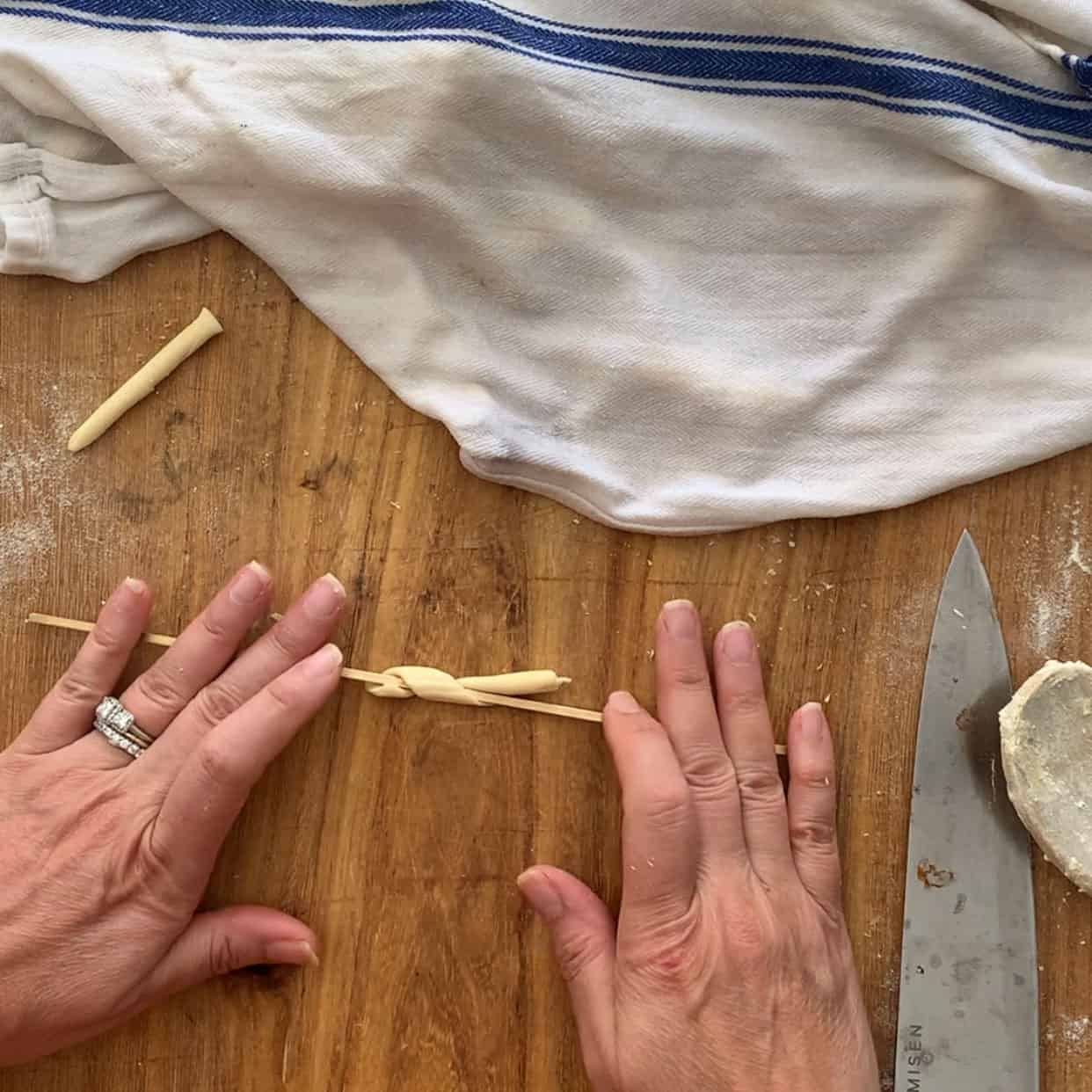

Make Ahead and Storage
Freezing
Homemade pasta dough using semolina comes together so quickly that it’s probably not worthwhile to freeze, as it would take longer to defrost than it would to simply make it from scratch.
If for some reason, you really want to freeze the dough, I recommend shaping it into your desired pasta shape first, then freezing on a baking tray. After frozen, the pasta can be transferred to a plastic freezer bag.
Boil the pasta straight from frozen stage without defrosting.
Drying and Refrigerating
Pasta dough may be refrigerated for 1 to 3 days and it must be wrapped well to prevent drying.
After shaping the pasta dough into fusilli, you may leave the shaped pasta on the counter for a few hours before boiling if desired or freeze as directed above.
📖 Recipe
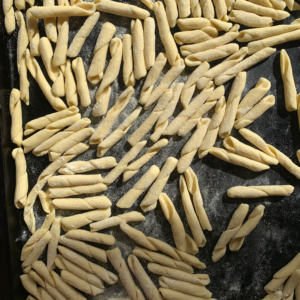
Making Fusilli with Homemade Semolina Pasta Dough
Equipment
- fusilli rod or wooden skewer
- large bowl to mix pasta dough
- wooden board nice to have, but not necessary to have
Ingredients
- 300 grams (2 cups) semolina (semola) finely ground semolina, plus extra for dusting baking sheets, counter
- 150 grams (2/3 cups) water hot
For Cooking
- salted water
For Serving
- pasta sauce of your choice
Instructions
To Make the Pasta Dough
- Add semolina to a large bowl
- Pour hot water on top and mix until all flour has been absorbed
- After all the flour has been incorporated, knead the dough for about 10 minutes until smooth.
- It helps to let it rest a few minutes between kneading.
- When the dough is smooth, cover under an inverted bowl, and let rest for at least 30 minutes on the counter.
- You can also let the dough rest in the refrigerator for up to 3 days in a air tight bag or container.
- After the dough has rested, determine if you want to make simple or spiral fusilli
To Shape the Pasta into Simple Fusilli
- Cut a golf ball sized piece of dough and roll into a thick long rope, about the thickness of your finger and a foot long.
- Ensure that any unworked dough is covered with a damp cloth or the dough will dry out and be difficult to work with.
- Cut the rope into several smaller pieces, about 2 or 3 inches in length.
- Using the fusilli rod, center the rod on top of a 2 to 3-inch dough piece, press down in the center (without pressing all the way through).
- Roll back and forth on the surface of your table or wooden board, applying enough pressure, to lengthen.
- Slide the pasta strand off the rod and then repeat until all dough is rolled.
- Carefully line up pasta strands on a cookie or baking sheet that has been lightly dusted with semolina or flour.
To Shape the Dough into Spiral Fusilli
- Flatten the pasta dough to about 1 inch thick disk and cut into several strips
- Ensure that you cover the dough you are actively working with a damp cloth so that it doesn't dry out – this step is very important
- Take a strip of dough and roll into a rope, and break each it up into several pieces.
- Continue to roll each smaller piece of dough into a thinner rope, about 1/4 inch in diameter and then cut the ropes into 2-inch long pieces.
- Using a fusilli iron or wooden skewer, angle the iron at a 45 degree angle at the start of each 2-inch strand, and roll the iron away from you, applying gentle pressure, to form the shape.
- Repeat until all dough is used up taking care to keep the dough covered with a damp cloth if it isn't being actively worked.
- Place formed pasta on semolina dusted tray and set aside until you are ready to cook.
To Store
- Pasta may be stored at room temperature for a few hours
- For extended storage, freeze the pasta loosely on a cookie sheet until frozen and then transfer to freezer bag
To Cook/Boil
- Boil homemade pasta in salted boiling water for 3 to 5 minutes.
- Test the pasta before removing/straining.
- Drain and serve with homemade pasta sauce or sauce of your choice.

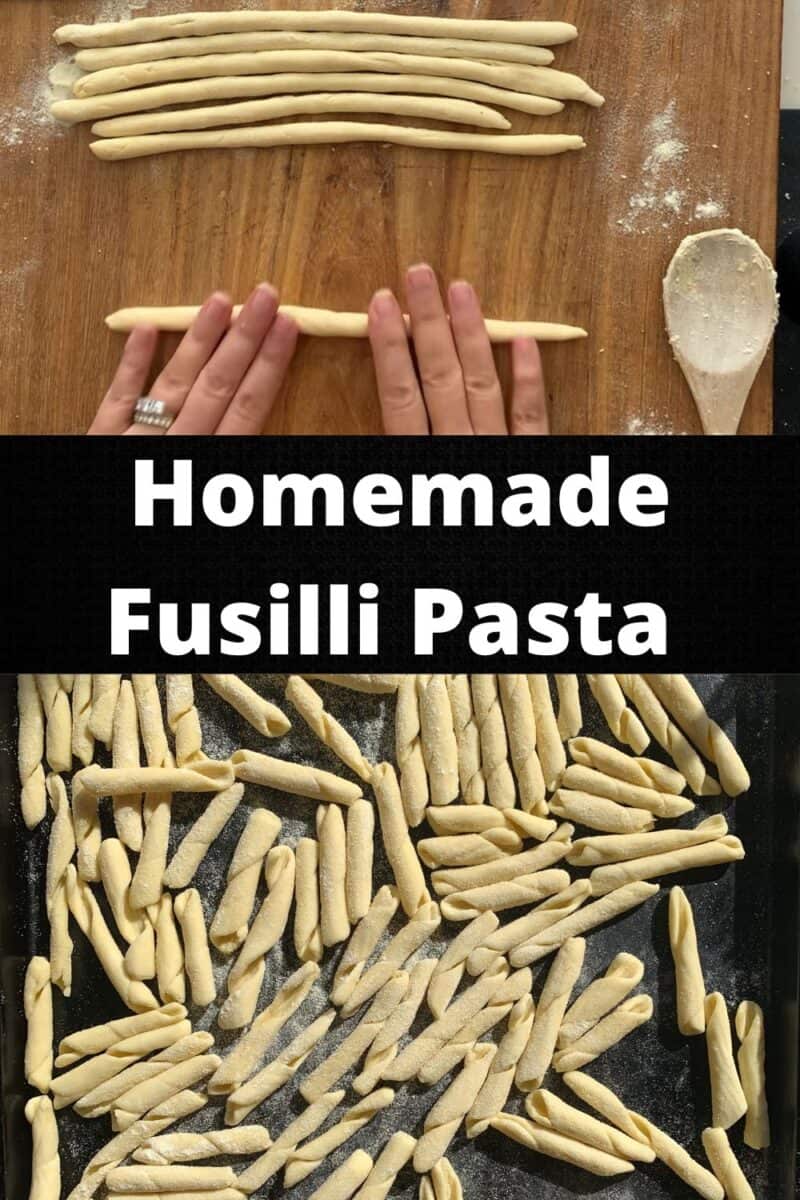
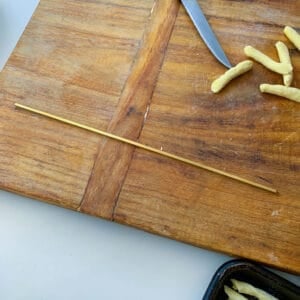
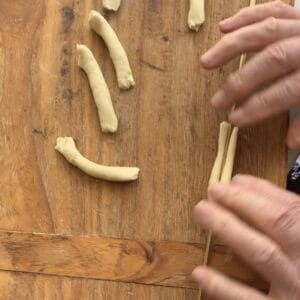
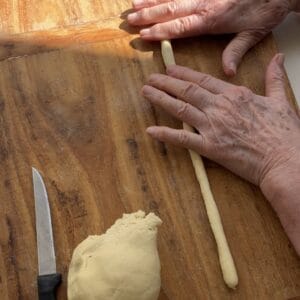


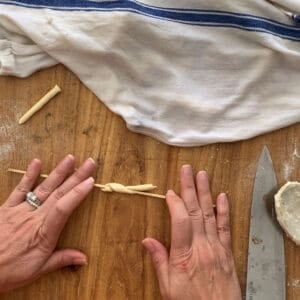
I have a question. I have a KitchenAid extruder attachment. Do you have any idea if this recipe will work with that? I just tried making dough with 340 grams of Caputo double milled semolina flour and 1/2 cup water. I mixed it in KitchenAid and I thought it was supposed to come out as wet sand, but instead came out more like a bread dough. I added in a couple of tablespoons more flour, but this was a disaster, lol. The fusilli disk didn’t seem to even form the dough properly. Any ideas? 🙂
There is a wonderful Facebook group for using pasta extruders that would be helpful – I have a Phillips, so I joined a while ago. I have read that the pasta dough recipes are tailored to the machines. Yes, the dough should be like sand or even small pieces, because the extruders on home machines are not that powerful. Here is the link if you want to join: pastafanatics facebook group